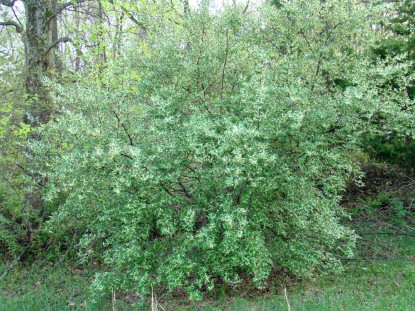
Eleagnus umbellata shrub – 10 feet tall
Not long after we moved onto our place–after the former owner’s cows had been gone a while, and after we stopped raising sheep–we noticed more and more little shrubs with silver leaves popping up.
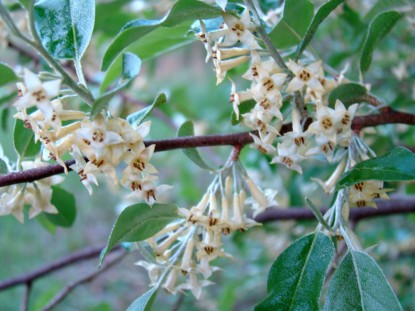
Eleagnus umbellata flowers – April
And they grew.
They bloom in the spring and the small white tubular flowers smell like warm spices from far away places. I thought they were enchanting, so we left them.
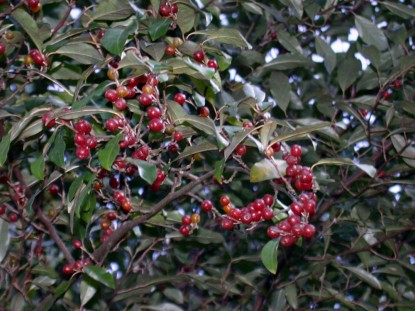
Eleagnus umbellata berries
And then they bore fruit and I figured out what they were: Eleagnus umbellata. (Think of it like a woman’s name: Elly Agnes.) The autumn olive.
And then we found out that they’re considered a pest here. Because the birds love them. And eat them. And poop their seeds everywhere. And now we have loads and loads and loads of them.
The red berries are small–about the size of the nail on your little finger–and have silver spots.
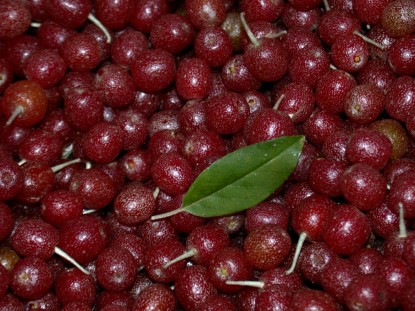
I did a lot of searching to find out if the berries are edible and indeed they are. They’re very acidic and have a large seed. If you taste one right off the tree, you’ll get that weird dry taste that you get from green bananas and unripe persimmons.
They’re abundant, they’re full of vitamin C, and they’re free, so I set about experimenting to see what kind of jam I could make.
The first thing I learned was that the redder they are, the better they are. Also, it’s best to not skimp on the sugar–these babies are tart, I tell you. Treat them like cranberries–be generous with the sweetener.
I tried eleagnus jam with a touch of lavender and lemon verbena–very nice, but not great. No one would eat it but me. Also, I had used pectin and that jelly was firm. Really firm. If only my butt were that firm.
Then this year, I tried it with oranges and no pectin and Hello! We have a winner! This jam is good! Everyone likes it.

And it’s really pretty. It tastes as good as it looks.
How to make Eleagnus Orange Jam:
Pick about 4 cups of berries. Make sure they’re good and red.
1/2 cup water
4 cups sugar
2 oranges, zest and juice
Wash the berries and put them in a pot with the water. Cook until they’re good and soft.
While they’re hot, pour them into a chinois or strainer and mash the berries to get the juice and pulp out.
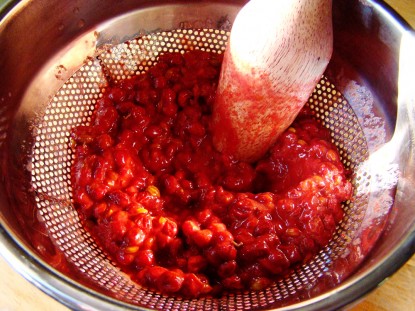
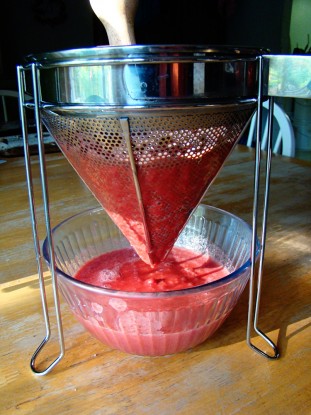
Don’t let the seeds fall into the juice and pulp. I don’t try to squeeze them all dry. Seeds are often bitter and I don’t want that in the jam, so I stop straining when things start getting dry and sticky and most of the juice and pulp is out.
Almost done…
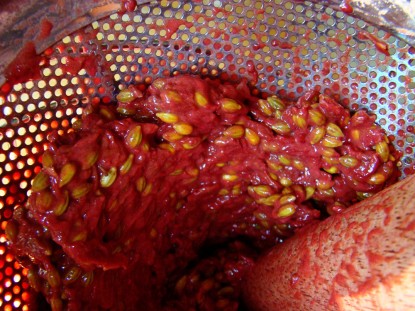
Discard the seeds and skins. Chickens like them. Put the pulp and juice back into the pot and add the sugar, orange zest and orange juice. Cook until it boils hard.
Jam!
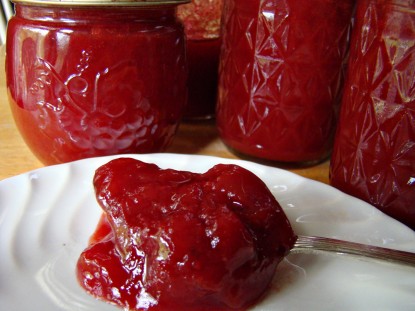
Ladle into jars and process for canning.
Get the handy print page and save this to your recipe box here:
Eleagnus Orange Jam.
Robin from Rurification blogs at Rurification. Do you have a recipe post or kitchen-related story to share on the Farm Bell blog?
See Farm Bell Blog Submissions for information, the latest blog contributor giveaway, and to submit a post.Want to subscribe to the Farm Bell blog? Go here.



bonita says:
They’re a pest here too. (Northern IL) Certainly a pretty jam for a pest!
On September 9, 2011 at 5:01 am
CindyP says:
I need to see if there are any “pests” around here! The jam is beautiful!
On September 9, 2011 at 7:37 am
Wildflower_VA says:
Thanks soooo much for this recipe! I just bought my farmstead last summer and discovered that I have a couple of these trees. After searching the ‘net, I discovered that they are the dreaded autumn olive. This year I have been looking for a recipe to preserve them for the winter and didn’t find much.
The mockingbirds like these berries really well, so I am hoping to get enough to make a few jars of jam. My chickens really like the berries, as well, so I will be feeding the pulp and seeds to them. I have read that the seeds are very nutritious, so they won’t be wasted if the chickens eat them.
On September 9, 2011 at 11:24 am
angela p says:
Yup Cindy, they are in our state. But what good news! We can eat them! And make them into jam! I had tons of these in my horse pasture, I jerked them out with chains attatched to the back of the truck. They do grow very fast and spread. I still have lots in my other field though…good thing. Im so excited to see this post! Wait until I share this with my dad! He is not a fan of this shrub. I cant wait to try this recipe just for him. Thanks Robin for all your research and posting about this very interesting jam!
On September 9, 2011 at 1:53 pm
Pete says:
Well, my or my – we may also have this, or a close relative! It’s my favorite bush/tree along the creek bank because of that wonderful aroma in the spring. Will have to look a bit closer at the shape of the blossom next spring, the the rest of the description is exactly what we have.
Thanks!
On September 10, 2011 at 8:26 am